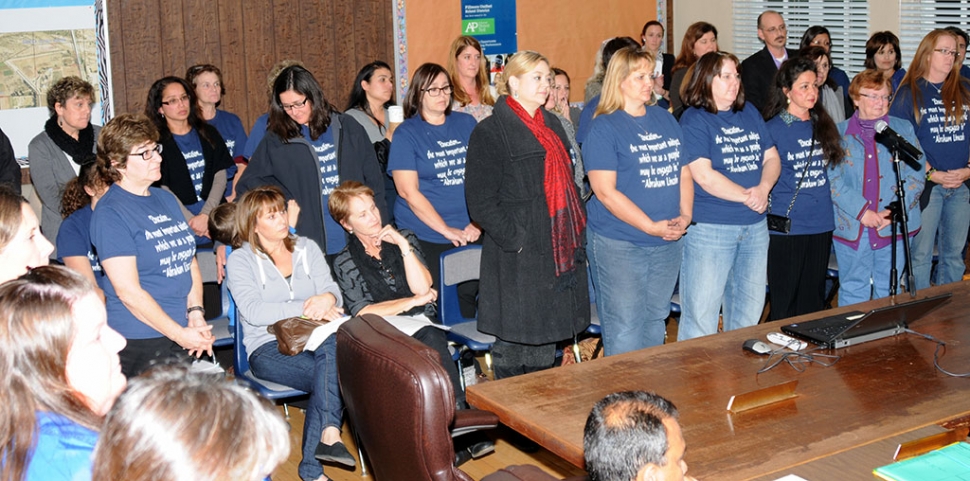|
Common Core Comes With a Huge Price Tag
 By Jean McLeod — Wednesday, February 5th, 2014
Last Tuesday the Fillmore Unified School District (FUSD) Board Meeting started with a packed room of over 70 teachers who came with a message for the Board; salary raises. The main agenda item was once again the implementation of Common Core State Standards (CCSS) and its enormous cost. The State Budget is providing for a one time funding amount of $766,070.00 that can only be spent on the initial implementation of professional development, instructional material and technology equipment. When asked if that amount will cover all cost associated with CCSS implementation, Superintendent Dr. Alan Nishino and Assistant Superintendent Michael Johnson both responded that if they are lucky the monies provided in this one time funding will cover about 50% of what is needed. This huge cost of implementation of the CCSS is becoming a problem for many school districts throughout the country. Forty-five states plus the District of Columbia have signed on to CCSS; many without doing any cost assessment. With the deadline of a January 1, 2014 for implementation having passed, many states are experiencing buyer’s remorse. According to a report on Foxnews.com California is "...estimated to spend approximately $35 million per year, or about $30 per student in testing costs alone." FUSD's proposed expenditures regarding the one time State funding are: Infrastructure $27,008.60; Site Specific Technology $389,230.91; Staff Development $200,000.00; Instructional Materials $149,830.49. A total of $292,000 which is a little less than half, has been spent so far: $3,000 on Infrastructure, $248,000 on Site Specific Technology, $20,000 Staff Development, $21,000 on Instructional Material. Throughout the country there are two groups charged with providing testing and learning materials. California uses Smart Balance, a state-led consortium assessment in English Language Arts and Math. With this approach they makes use of computer adaptive technology that asks students tailored questions based on their previous answers. The other path is Partnership for Assessment of Readiness for College and Career (PARCC) a consortium of states that have worked together to develop a common set of K-12 computer based assessments in English and Math that coincide with CCSS. This approach is designed to eliminate the end term tests with assessments administered several times during the year resulting in an average final score. The planned use of these initial funds will be: provide in services for certificated and classified classroom staff on the new content standards and develop curriculum aligned to the new standards; adopt and purchase current standards-aligned to instructional material for English language arts and mathematics; upgrade the technology and infrastructure for improved internet access and meet Smarter Balance Technology Strategy Framework and System Requirements Specifications; purchase additional computers and supporting hardware and software for technology-based instruction. Johnson told the Board "the lion's share (of the State funds received) is needed for the technology.... the cost projections so far do not even included the cost of maintaining and upgrading the technology" and he suggested the possibility of asking for a bond to help cover costs. Eighteen months ago FUSD hired Mike Pace and two other IT techs to setup the network and maintain it, but the State has been slow at giving directions on implementation to schools throughout the state. Johnson described it as, "They're (the State) fixing the plane while they're flying the plane." The 160 FUSD teachers have their own 35 computers lab, but all seven school sites need upgrading, including the new Rio Vista Elementary. The District is looking into two teaching software programs, Waterford Software which focuses on elementary education and SuccessMaker for the secondary grades. These two software programs along with the Windows 7 operating system will be costly to the district. Last year FUSD spent $212,000 on K-6th grade Common Core Math Texts. The K-8 textbooks are determined by the State and the 9-12th grade text is chosen by the Board. The administration is postponing purchases of all additional textbooks needed until next year in anticipation of expected corrections that happen in the process of implementing such changes in teaching. During Public Comments teachers Sandra Butts, Josh Overton, Janey Munoz and John Shaper along with over 70 teachers in attendance, addressed the Board regarding the budget not having salary raises for them. The teachers at FUSD have not received a raise in over six years. Overton ended his address to the Board by stating, "Please recognize our continued efforts and past sacrifices." Most who addressed the Board spoke of the furlough days they had received in the past, lack of resources/supplies and the increase in class size. California's economy is said to be improving, but with that said, there are signs that it is not on solid ground yet and California's education funding is predicated on a healthy economy both today and in the future. The big question is will there be enough money to satisfy all the needs of an extremely expensive transition in education and also give those doing the teaching the raises they want? Or will Proposition 30, which is expected to sunset the end of 2016, just become another permanent tax hike? Each year California spends 53% of its general fund on educations (over $50 billion), but it seems that is still not enough. |
